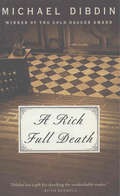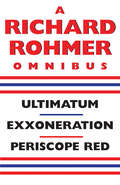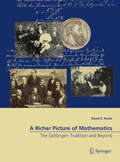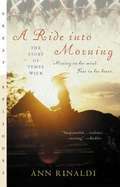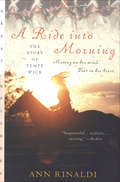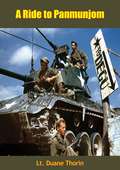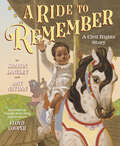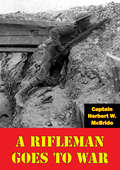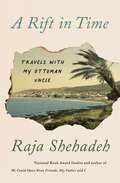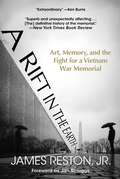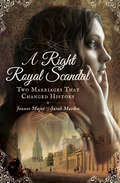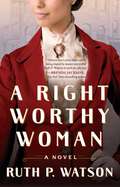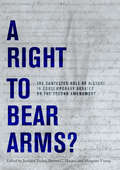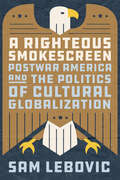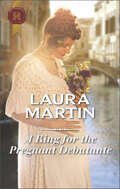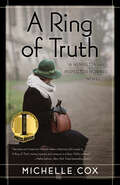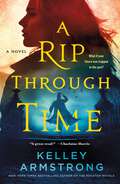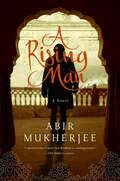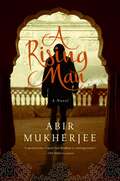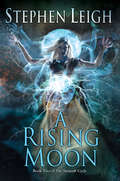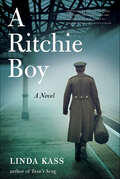- Table View
- List View
A Rich Full Death
by Michael DibdinFlorence, 1855. "The English are dying too much," the city's police chief observes. And members of the foreign community in this quaint Italian backwater, both English and American, are indeed dying at an alarming rate and in an extraordinary variety of ingenious and horrible ways. With the local authorities out of their depth, the distinguished resident Robert Browning launches his own private investigation, aided and abetted by an ex-patriot Robert Booth. Unfortunately, their amateur sleuthing is hampered by the fact that each of their suspects becomes the next victim in a series of murders orchestrated by a killer with a taste for poetic justice. A Rich Full Death features characters both historical and imaginary, ranging from an enticing servant girl to Mr. Browning's consumptive, world-famous wife, Elizabeth Barrett, in a tale lush with period detail, intricately plotted, and with a truly astonishing final twist.
A Richard Rohmer Omnibus
by Richard RohmerThis volume combines three of Richard Rohmer’s best-selling novels in one book. Ultimatum, Exxoneration, and Periscope Red are all fast-paced, incisive novels in which Rohmer makes fiction read like fact. They are chilling visions of a world of military conflict, legal and political entanglements, and Canada’s role in domestic and international spheres. The issues inside are just as important to Canada today as they were when the books were written. In all of these works, Rohmer demonstrates his insider’s knowledge of the energy industry and the military, and his master storyteller’s ability to bring it alive.
A Richer Heritage
by Robert E. StipeSurveying the past, present, and future of historic preservation in America, this book features fifteen essays by some of the most important voices in the field. A Richer Heritage will be an essential, thought-provoking guide for professionals as well as administrators, volunteers, and policy makers involved in preservation efforts.An introduction traces the evolution of historic preservation in America, highlighting the principal ideas and events that have shaped and continue to shape the movement. The book also describes the workings--legal, administrative, and fiscal--of the layered federal, state, and local government partnership put in place by Congress in 1966. Individual chapters explore the preservation of designed and vernacular landscapes, the relationship between historic preservation and the larger environmental and land-trust movements, the role of new private and nonprofit players, racial and ethnic interests in historic preservation, and the preservation of our intangible cultural values. A concluding chapter analyzes the present state of the historic preservation movement and suggests future directions for the field in the twenty-first century. Contributors include preservationists, local-government citizen activists, an architect, landscape architects, environmentalists, an archaeologist, a real-estate developer, historians, a Native American tribal leader, an ethnologist, and lawyers.
A Richer Picture of Mathematics: The Göttingen Tradition and Beyond
by David E. RoweHistorian David E. Rowe captures the rich tapestry of mathematical creativity in this collection of essays from the “Years Ago” column of The Mathematical Intelligencer. With topics ranging from ancient Greek mathematics to modern relativistic cosmology, this collection conveys the impetus and spirit of Rowe’s various and many-faceted contributions to the history of mathematics. Centered on the Göttingen mathematical tradition, these stories illuminate important facets of mathematical activity often overlooked in other accounts. Six sections place the essays in chronological and thematic order, beginning with new introductions that contextualize each section. The essays that follow recount episodes relating to the section’s overall theme. All of the essays in this collection, with the exception of two, appeared over the course of more than 30 years in The Mathematical Intelligencer. Based largely on archival and primary sources, these vignettes offer unusual insights into behind-the-scenes events. Taken together, they aim to show how Göttingen managed to attract an extraordinary array of talented individuals, several of whom contributed to the development of a new mathematical culture during the first decades of the twentieth century.
A Ride Into Morning: The Story of Tempe Wick
by Ann RinaldiThe Revolutionary War is raging. General Wayne's soldiers are freezing, underpaid and resentful. Whispers of mutiny abound. A stone's throw from the restless camp, Tempe Wick wages her own battle for survival. Despite her efforts, she fears she won't be able to feed her family, care for her ailing mother, or maintain her farm for long. As the whispers get louder, the soldiers get bolder. Mutiny is imminent. And Tempe faces a gut-wrenching decision: Should she join the revolt? Ann Rinaldi's dramatic story is based on the legend of America's Tempe Wick.
A Ride into Morning: The Story of Tempe Wick (Great Episodes)
by Ann RinaldiA &“suspenseful [and] exciting&” tale of a young woman&’s battle to save her beloved horse during the Revolutionary War, inspired by a true story (Booklist). The Revolutionary War is raging. Food and firewood are scarce, and Tempe Wick is worried that she will not be able to care for her ailing mother and her family and still maintain their farm in New Jersey, where troops are now camped. Her ability to hold on to her world is further threatened when a mutinous soldier demands that she lend him her beloved horse, Colonel, in exchange for keeping her brother&’s rum-smuggling activities secret from the authorities. This dramatic historical novel is based on a real event that has been popularized into American legend. &“Crammed with authentic detail.&” —Kirkus ReviewsA New York Public Library Book for the Teen Age
A Ride to Panmunjom
by Lt. Duane ThorinLt. Duane Thorin was a Navy helicopter pilot, who rescued many Americans before he himself was captured in 1952 and held as a prisoner of war by North Korea until his release in August, 1953.This book, first published in 1956, is a fictional account of men in Korean POW camps, based on Lt. Thorin’s own experiences, as well as those of other prisoners of war in North Korea.
A Ride to Remember: A Civil Rights Story
by Sharon Langley Amy NathanThe true story of how a 1963 ride on a carousel in Maryland made a powerful Civil Rights statement. A Ride to Remember tells how a community came together—both black and white—to make a change. When Sharon Langley was born in the early 1960s, many amusement parks were segregated, and African-American families were not allowed entry. This book reveals how in the summer of 1963, due to demonstrations and public protests, the Gwynn Oak Amusement Park in Maryland became desegregated and opened to all for the first time. Co-author Sharon Langley was the first African-American child to ride the carousel. This was on the same day of Martin Luther King Jr.’s March on Washington for Jobs and Freedom. Langley’s ride to remember demonstrated the possibilities of King’s dream. This book includes photos of Sharon on the carousel, authors’ notes, a timeline, and a bibliography.“Delivers a beautiful and tender message about equality from the very first page.” —Kirkus Reviews, Starred Review“Cooper’s richly textured illustrations evoke sepia photographs’ dreamlike combination of distance and immediacy, complementing the aura of reminiscence that permeates Langley and Nathan’s narrative.” —Publishers Weekly, Starred Review“A solid addition to U.S. history collections for its subject matter and its first-person historical narrative.” —School Library Journal
A Rifleman Goes To War [Illustrated Edition]
by Captain Herbert W. McBrideIncludes the First World War Illustrations Pack - 73 battle plans and diagrams and 198 photosThe classic account of sniping on the Western Front."Herbert Wesley McBride was a Captain in the Twenty-first Battalion, Canadian Expeditionary Force, during the First World War. He was a sniper and commander of a machine gun unit known as the "Emma Gees." He was also the author of two books on the war: "A Rifleman Went To War" (1933) and "The Emma Gees" (1918)...When the war started, he volunteered in a Canadian rifle company in Ottawa because he wanted to see action as quickly as possible. He was commissioned as an officer, but was reduced to a private due to several drunken incidents. He shipped to England for training and then to the Western Front, where he participated in battles around Ypres and the Somme throughout 1916. In his book, "A Rifleman Went To War," he recounts killing more than 100 German soldiers as a sniper. This book is highly regarded by students of riflery, it's mandatory reading in the U.S. Marine Corps Sniping School. It is also considered one of the best first-person accounts of World War I, often being compared favorably to "Storm of Steel" by Ernst Junger. However McBride notes in his book that by the end of 1916 he felt in his heart "the game was over," and a series of alcoholic binges resulted in his court martial and dismissal from the Canadian Expeditionary Force in February 1917. He then joined the United States Army's 38th Division, serving out the war as a marksmanship and sniping instructor at Camp Perry. He resigned in October 1918. After the war, he worked in the lumber industry in Oregon for most of his later years. He died in Indianapolis of a sudden heart failure on March 17, 1933, shortly after finishing "A Rifleman Went To War." He was 60."-Canadaatwar.com
A Rift in Time: Travels with My Ottoman Uncle
by Raja ShehadehThe quest for his great-uncle Najib Nassar, an Ottoman journalist - the details of his life, and the route of his great escape from occupied Palestine - consumed award-winning writer Raja Shehadeh for two years. As he traces Najib's footsteps, he discovers that today it would be impossible to flee the cage that Palestine has become. "A Rift in Time" is a family memoir written in luminescent prose, but it is also a reflection on how Palestine - in particular the disputed Jordan Rift Valley - has been transformed. Most of Palestine's history and that of its people is buried deep in the ground: whole villages have disappeared and names have been erased from the map. Yet by seeing the bigger picture of the landscape and the unending struggle for freedom as Shehadeh does, it is still possible to look towards a better future, free from Israeli or Ottoman oppression.
A Rift in Time: Travels with My Ottoman Uncle
by Raja ShehadehAn engrossing family memoir that shines a light on Palestine&’s history, offering a wise, sobering view of how radically conditions there have changed since the late Ottoman Empire, from the award-winning author of We Could Have Been Friends, My Father and I.Raja Shehadeh&’s great-great-uncle Najib Nassar, a journalist born in 1865, spent the first 4 decades of his life under the Ottoman Empire. Ruled by a Muslim Sultan, the region nevertheless saw the coexistence of Christianity, Judaism, and Islam, and a freedom of movement unthinkable in the present-day Middle East. On a 2-year quest to discover Najib&’s fascinating story, Shehadeh follows his footsteps through what are now Lebanon and Israel, tracing the fall of the Empire after World War I and the disastrous British Mandate. A family memoir written in luminescent prose, A Rift in Time also reflects on how Palestine—in particular the disputed Jordan Rift Valley—has been transformed. Most of Palestine&’s history and that of its people is buried deep in the ground: whole villages have disappeared, and names have been erased from the map. Yet by seeing the bigger picture of the landscape and the unending struggle for freedom as Shehadeh does, it is still possible to look toward a better future.
A Rift in the Earth: Art, Memory, and the Fight for a Vietnam War Memorial
by James Reston Jr.A Distinguished and Bestselling Historian and Army Veteran Revisits the Culture War that Raged around the Selection of Maya Lin's Design for the Vietnam Memorial A Rift in the Earth tells the remarkable story of the ferocious “art war” that raged between 1979 and 1984 over what kind of memorial should be built to honor the men and women who died in the Vietnam War. The story intertwines art, politics, historical memory, patriotism, racism, and a fascinating set of characters, from those who fought in the conflict and those who resisted it to politicians at the highest level. At its center are two enduring figures: Maya Lin, a young, Asian-American architecture student at Yale whose abstract design won the international competition but triggered a fierce backlash among powerful figures; and Frederick Hart, an innovative sculptor of humble origins on the cusp of stardom. James Reston, Jr., a veteran who lost a close friend in the war and has written incisively about the conflict's bitter aftermath, explores how the debate reignited passions around Vietnam long after the war’s end and raised questions about how best to honor those who fought and sacrificed in an ill-advised war. Richly illustrated with photographs from the era and design entries from the memorial competition, A Rift in the Earth is timed to appear alongside Ken Burns's eagerly anticipated PBS documentary, The Vietnam War. “The memorial appears as a rift in the earth, a long polished black stone wall, emerging from and receding into the earth."—Maya Lin "I see the wall as a kind of ocean, a sea of sacrifice. . . . I place these figures upon the shore of that sea." —Frederick Hart
A Right Royal Scandal: Two Marriages That Changed History
by Joanne Major Sarah MurdenFrom the authors of An Infamous Mistress: &“The tale of two juicy 19th-century scandals, both concerning the aristocratic Cavendish-Bentinck family&” (Cheshire Life). Almost two books in one, A Right Royal Scandal recounts the fascinating history of the irregular love matches contracted by two successive generations of the Cavendish-Bentinck family, ancestors of the British royal family. The first part of this intriguing book looks at the scandal that erupted in Regency London, just months after the Battle of Waterloo, when the widowed Lord Charles Bentinck eloped with the Duke of Wellington&’s married niece. Over two decades later and while at Oxford University, Lord Charles&’ eldest son fell in love with a beautiful Romany girl, and secretly married her. When his alliance was discovered, he was cast adrift by his family—with devastating consequences. A love story as well as a brilliantly researched historical biography, this is a continuation of Joanne Major and Sarah Murden&’s first biography, An Infamous Mistress, about the eighteenth-century courtesan Grace Dalrymple Elliott, whose daughter was the first wife of Lord Charles Bentinck. The book ends by showing how, if not for a young gypsy and her tragic life, the British monarchy would look very different today. &“An easy read of a subject that keeps you engrossed from start to finish. This book is brilliant for those who enjoy the scandals of historical television, with the added authenticity of historical fact.&” —History of Royals &“The plots may seem to come straight out of the world of Regency Romance but they are all true, and carefully annotated and verified by Major and Murden.&” —Naomi Clifford, author of The Murder of Mary Ashford
A Right Worthy Woman: A Novel
by Ruth P. WatsonIn the vein of The Engineer&’s Wife and Carolina Built, an inspiring novel based on the remarkable true story of Virginia&’s Black Wall Street and the indomitable Maggie Lena Walker, the daughter of a formerly enslaved woman who became the first Black woman to establish and preside over a bank in the United States.Maggie Lena Walker was ambitious and unafraid. Her childhood in 19th-century Virginia helping her mother with her laundry service opened her eyes to the overwhelming discrepancy between the Black residents and her mother&’s affluent white clients. She vowed to not only secure the same kind of home and finery for herself, but she would also help others in her community achieve the same. With her single-minded determination, Maggie buckled down and went from schoolteacher to secretary-treasurer of the Independent Order of St. Luke, founder of a newspaper, a bank, and a department store where Black customers were treated with respect. With the help of influential friends like W.E.B. DuBois and Mary McLeod, she revolutionized Richmond in ways that are still felt today. Now, her rich, full story is revealed in this stirring and intimate novel.
A Right to Bear Arms?: The Contested Role of History in Contemporary Debates on the Second Amendment
by Barton C. Hacker Jennifer Tucker Margaret ViningThis collection of essays explores the way history itself has become a contested element within the national legal debate about firearms. The debate over the Second Amendment has unveiled new and useful information about the history of guns and their possession and meaning in the United States of America. History itself has become contested ground in the debate about firearms and in the interpretation of the Second Amendment to the Constitution of the United States. Specifically this collection of essays gives special attention to the important and often overlooked dimension of the applications of history in the law. These essays illustrate the complexity of the firearms debate, the relation between law and behavior, and the role that historical knowledge plays in contemporary debates over law and policy. Wide-ranging and stimulating The Right to Bear Arms is bound to captivate both historians and casual readers alike.
A Righteous Smokescreen: Postwar America and the Politics of Cultural Globalization
by Sam LebovicAn examination of how the postwar United States twisted its ideal of “the free flow of information” into a one-sided export of values and a tool with global consequences. When the dust settled after World War II, the United States stood as the world’s unquestionably pre-eminent military and economic power. In the decades that followed, the country exerted its dominant force in less visible but equally powerful ways, too, spreading its trade protocols, its media, and—perhaps most importantly—its alleged values. In A Righteous Smokescreen, Sam Lebovic homes in on one of the most prominent, yet ethereal, of those professed values: the free flow of information. This trope was seen as capturing what was most liberal about America’s self-declared leadership of the free world. But as Lebovic makes clear, even though diplomats and public figures trumpeted the importance of widespread cultural exchange, these transmissions flowed in only one direction: outward from the United States. Though other countries did try to promote their own cultural visions, Lebovic shows that the US moved to marginalize or block those visions outright, highlighting the shallowness of American commitments to multilateral institutions, the depth of its unstated devotion to cultural and economic supremacy, and its surprising hostility to importing foreign cultures. His book uncovers the unexpectedly profound global consequences buried in such ostensibly mundane matters as visa and passport policy, international educational funding, and land purchases for embassies. Even more crucially, A Righteous Smokescreen does nothing less than reveal that globalization was not the inevitable consequence of cultural convergence or the natural outcome of putatively free flows of information—it was always political to its core.
A Righteous Smokescreen: Postwar America and the Politics of Cultural Globalization
by Sam LebovicAn examination of how the postwar United States twisted its ideal of “the free flow of information” into a one-sided export of values and a tool with global consequences. When the dust settled after World War II, the United States stood as the world’s unquestionably pre-eminent military and economic power. In the decades that followed, the country exerted its dominant force in less visible but equally powerful ways, too, spreading its trade protocols, its media, and—perhaps most importantly—its alleged values. In A Righteous Smokescreen, Sam Lebovic homes in on one of the most prominent, yet ethereal, of those professed values: the free flow of information. This trope was seen as capturing what was most liberal about America’s self-declared leadership of the free world. But as Lebovic makes clear, even though diplomats and public figures trumpeted the importance of widespread cultural exchange, these transmissions flowed in only one direction: outward from the United States. Though other countries did try to promote their own cultural visions, Lebovic shows that the US moved to marginalize or block those visions outright, highlighting the shallowness of American commitments to multilateral institutions, the depth of its unstated devotion to cultural and economic supremacy, and its surprising hostility to importing foreign cultures. His book uncovers the unexpectedly profound global consequences buried in such ostensibly mundane matters as visa and passport policy, international educational funding, and land purchases for embassies. Even more crucially, A Righteous Smokescreen does nothing less than reveal that globalization was not the inevitable consequence of cultural convergence or the natural outcome of putatively free flows of information—it was always political to its core.
A Ring for the Pregnant Debutante
by Laura MartinFrom baby bump to marriage vows!Rosa Rothwell knows her pregnancy is scandalous. She will do anything to protect her baby, even staging a daring escape from her family’s Italian home. Rosa has no idea what the future holds—until a handsome but infuriating stranger offers his help.Convinced his family is cursed, Lord Hunter believes he’s far better off alone. But the pregnant debutante’s sweet nature touches him deeply. Can he confront his demons at last, and give them both a new future…as husband and wife?
A Ring of Truth: A Henrietta and Inspector Howard Novel (A Henrietta and Inspector Howard Novel)
by Michelle Cox“Mixing Romance and Mystery in a Fizzy 1930s Cocktail!”“Henrietta and Inspector Howard make a charming odd couple in A Ring of Truth, mixing mystery and romance in a fizzy 1930s cocktail.” ―Hallie Ephron, New York Times bestselling author “The crème de la crème of historical fiction,” ― Brit+Co “Brimming with dark plot on every page, this unpredictable literary thrill ride will transport you to the heart of 1930s Chicago and the love story of a lifetime.” ― POPSUGAR In this second book of the series, Henrietta and Clive delightfully rewrite Pride and Prejudice—with a hint of mystery!Newly engaged, Clive and Henrietta now begin the difficult task of meeting each other’s family. “Difficult” because Clive has neglected to tell Henrietta that he is in fact the heir to the Howard estate and fortune, and Henrietta has just discovered that her mother has been hiding secrets about her past as well. When Clive brings Henrietta to the family estate to meet his parents, they are less than enthused about his impoverished intended. Left alone in this extravagant new world when Clive returns to the city, Henrietta finds herself more at home with the servants than his family, much to the disapproval of Mrs. Howard—and soon gets caught up in the disappearance of an elderly servant’s ring, not realizing that in doing so she has become part of a bigger, darker plot.As Clive and Henrietta attempt to discover the truth in the two very different worlds unraveling around them, they both begin to wonder: Are they meant for each other after all?
A Rip Through Time: A Novel (Rip Through Time Novels #1)
by Kelley ArmstrongIn this series debut from New York Times bestselling author Kelley Armstrong, a modern-day homicide detective finds herself in Victorian Scotland—in an unfamiliar body—with a killer on the loose."A great read." —Charlaine HarrisMAY 20, 2019: Homicide detective Mallory Atkinson is in Edinburgh to be with her dying grandmother. While out on a jog one evening, Mallory hears a woman in distress. She’s drawn to an alley, where she is attacked and loses consciousness.MAY 20, 1869: Housemaid Catriona Mitchell had been enjoying a half day off, only to be discovered that night strangled and left for dead . . . exactly one hundred and fifty years before Mallory is strangled in the same spot.When Mallory wakes up in Catriona’s body in 1869, she must put aside her shock and adjust quickly to her new reality: life as a housemaid to an undertaker in Victorian Scotland. She soon discovers that her boss, Dr. Gray, also moonlights as a medical examiner and has just taken on an intriguing case, the strangulation of a young man, similar to the attack on herself. Her only hope is that catching the murderer can lead her back to her modern life . . . before it’s too late.In A Rip Through Time, New York Times bestselling author Kelley Armstrong introduces a brand-new series mixing mystery, romance, and fantasy with thrilling results.
A Rising Man
by Abir MukherjeeCalcutta, 1919. Captain Sam Wyndham, former Scotland Yard detective, is a new arrival to Calcutta. Desperately seeking a fresh start after his experiences during the Great War, Wyndham has been recruited to head up a new post in the police force. He is immediately overwhelmed by the heady vibrancy of the tropical city, but with barely a moment to acclimatize or to deal with the ghosts that still haunt him, Wyndham is caught up in a murder investigation that threatens to destabilize a city already teetering on the brink of political insurgency. The body of a senior official has been found in a filthy sewer, and a note left in his mouth warns the British to quit India, or else. Under tremendous pressure to solve the case before it erupts into increased violence on the streets, Wyndham and his two new colleagues--arrogant Inspector Digby and Sergeant Banerjee, one of the few Indians to be recruited into the new CID--embark on an investigation that will take them from the opulent mansions of wealthy British traders to the seedy opium dens of the city.Masterfully evincing the sights, sounds, and smells of colonial Calcutta, A Rising Man is the start of an enticing new historical crime series.
A Rising Man: A Novel (Sam Wyndham Ser. #1)
by Abir MukherjeeIn the days of the Raj, a newly arrived Scotland Yard detective is confronted with the murder of a British official—in his mouth a note warning the British to leave India, or else... Calcutta, 1919. Captain Sam Wyndham, former Scotland Yard detective, is a new arrival to Calcutta. Desperately seeking a fresh start after his experiences during the Great War, Wyndham has been recruited to head up a new post in the police force. He is immediately overwhelmed by the heady vibrancy of the tropical city, but with barely a moment to acclimatize or to deal with the ghosts that still haunt him, Wyndham is caught up in a murder investigation that threatens to destabilize a city already teetering on the brink of political insurgency. The body of a senior official has been found in a filthy sewer, and a note left in his mouth warns the British to quit India, or else. Under tremendous pressure to solve the case before it erupts into increased violence on the streets, Wyndham and his two new colleagues—arrogant Inspector Digby and Sergeant Banerjee, one of the few Indians to be recruited into the new CID—embark on an investigation that will take them from the opulent mansions of wealthy British traders to the seedy opium dens of the city. Masterfully evincing the sights, sounds, and smells of colonial Calcutta, A Rising Man is the start of an enticing new historical crime series.
A Rising Moon (Sunpath #2)
by Stephen LeighThe second novel in this gripping historical fantasy series, set in an alternate first-century Britain, follows Orla Paorach, freedom fighter and daughter of a Boudica-like warrior."Orla! Hurry, girl! You must come with me!" Orla Paorach's life was overturned for the first time when her mother Voada was beaten senseless, and Orla was taken by Bakir, a minor Mundoan army officer, as his second wife. Now her world is shattered a second time: Bakir has died in battle, and so has her mother, now known as the Mad Draoi of the Cateni.Orla flees northward to Onglse, the island home of the draoi that is the center of the Cateni rebellion against the Mundoa. She becomes quickly embroiled in battle as well as deceptions from both sides of the conflict, as everyone expects that she's come to take up her mother's mantle. Those who knew her mother offer their help, but can she trust any of them? Can she avoid becoming the Mad Draoi herself, lost in the magic her mother once tried to wield?An intense, fast-paced novel, A Rising Moon explores trust, courage, and the deep seduction of power.
A Ritchie Boy: A Novel
by Linda KassFrom the author of Tasa’s Song, an extraordinary narrative about one young immigrant’s triumph in America, inspired by true events. 1938. Eli Stoff and his parents, Austrian Jews, escape to America just after Germany takes over their homeland. Within five years, Eli enlists in the US Army and, thanks to his understanding of the German language and culture, joins thousands of others like him who become known as Ritchie boys, young men who work undercover in Intelligence on the European front to help the Allies win World War II. In A Ritchie Boy, different characters tell interrelated stories that, together, form a cohesive narrative about the circumstances and people Eli encounters from Vienna to New York, from Ohio to Maryland to war-torn Europe, before he returns to the heartland of his new country to set down his roots. Set during the dawn of World War II and the disruptive decade to follow, A Ritchie Boy is the poignant, compelling tale of one young immigrant's triumph over adversity as he journeys from Europe to America, and from boyhood to manhood.
A River Ran Wild: An Environmental History
by Lynne CherryAn environmental history of the Nashua River, from its discovery by Indians through the polluting years of the Industrial Revolution to the ambitious cleanup that revitalized it.
